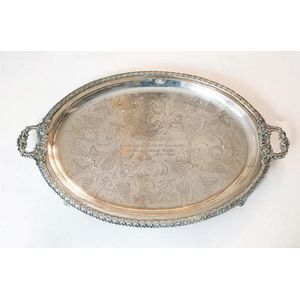Victorian Sterling Silver Salver with Eastern Inspiration
You must be a subscriber, and be logged in to view price and dealer details.
Subscribe Now to view actual auction price for this item
When you subscribe, you have the option of setting the currency in which to display prices to $Au, $US, $NZ or Stg.
- Salver - A plate or tray used for the formal offering of food, drink, letters or visiting cards, usually of silver plate, silver or silver-gilt. Large, heavy, oblong or oval silver salvers evolved into what we know as trays in the 18th century. Small, flat salvers are known as waiters.
- Engraving - The method of decorating or creating inscriptions on silver and other metal objects by marking the surface with a sharp instrument such as a diamond point or rotating cutting wheel.
- Hallmarks - A mark stamped on articles of precious metals in Britain, since the 14th century, certifying their purity. It derives its name from the Guild Hall of the Goldsmiths' Company, who recieved its Charter in 1327 giving it the power to assay (test the purity) and mark articles of gold and silver.
The hallmark will consist of several marks, including the:
- silver standard mark, indicating the purity of the metal. Sterling silver is .925 pure silver.
- the city mark indicating the city in which it was assayed eg London, Birmingham, York etc.
- the date mark, usually a letter of the alphabet in a particular font and case,
- a duty mark, indicating whether duty had been paid to the crown, and only in use from 1784 to 1890
The piece may include an additional mark, the maker's mark, although not forming part of the hallmark, will be located in the vicinity of the hallmarks.
Sometimes silver plated items will bear faux hallmarks, often confusing those not familiar with silver markings. - Victorian Period - The Victorian period of furniture and decorative arts design covers the reign of Queen Victoria from 1837 to 1901. There was not one dominant style of furniture in the Victorian period. Designers used and modified many historical styles such as Gothic, Tudor, Elizabethan, English Rococo, Neoclassical and others, although use of some styles, such as English Rococo and Gothic tended to dominate the furniture manufacture of the period.
The Victorian period was preceded by the Regency and William IV periods, and followed by the Edwardian period, named for Edward VII (1841 ? 1910) who was King of the United Kingdom and the British Dominions and Emperor of India for the brief period from 1901 until his death in 1910.
This item has been included into following indexes:
Visually similar items

A good Victorian period crested silver waiter, with gadroon border, finely engraved floral decoration and three shell and scroll feet. London 1871 by Elkington & Co. (Frederick Elkington). Weight 385gms. Diameter 19.5 cm

Elkington & Co silver plated two handled banquet tray oval shape with cast rim, with floral engraved centre and 1891 presentation inscription to Thomas page, 67 cm width

A Song dynasty bowl with moulded birds decoration, 17.5 cm diameter. The Estate of Stanley Crawford Stevens.

Georgian hallmarked sterling silver salver. London 1822. Maker EI. Monogrammed to top; underside with inscription Lt. Col. and Mrs Ironmonger to Mrs Pickering, Forton farm 1831. Three ball and claw feet. Diameter 31 cm. Weight. 850g
